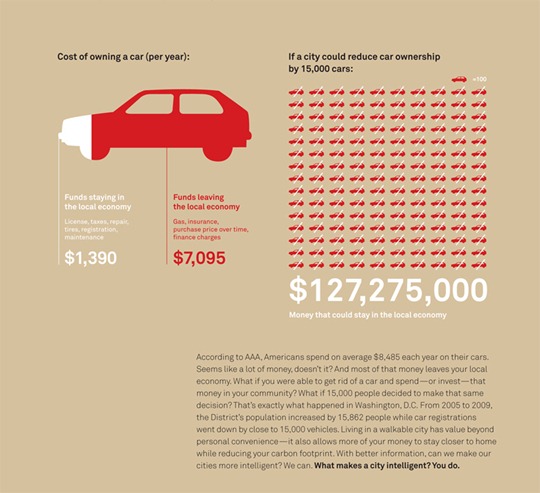Car-addicted societies have a tendency to believe that people in cars spend more money than people who arrive on foot, transit or by bicycle, and businesses and motorists will defend on-street parking at all costs.
For me personally, I have to admit that I spend more freely now that I have removed myself from the imprisonment of automobile ownership. The average of $6,000-$8,000 a year that I save from living car-free makes it easier to spend more money on local businesses and worry less about my personal finances.
A study in Toronto seems to support the theory that people who arrive sans automobile spend more than those who arrive by automobile.
Despite the fact that businesses overestimate the number of customers that arrive by car, the study found that 4 out of 5 people do not in fact drive to the particular study area and people who arrive by transit, foot or bicycle “visit more often and report spending more money than those who drive”.
Another interesting study from Melbourne found that re-allocating car parking spaces to bicycles could increase hourly revenue for businesses by about 5 times. The study found that in Melbourne, car drivers do spend more on shopping when they park their car than bicyclists do. But since car parking takes up several multiples of the space that bicycles require, businesses can increase their revenue by re-allocating that space to bicyclists.
Investing in bicycle infrastructure on our streets is also a great way to attract more customers, since streets with bike lanes attract more bicyclists than those parallel routes that lack infrastructure.
A bicycle count study in Toronto found that two parallel streets with bike lanes carry 53% of all bicycle traffic on the west side of the downtown core – even though these streets only represent less than 20% of the total streets available to bicyclists.
By attracting more bicyclists, businesses on these streets benefit. During the 12-hour study period, these two streets saw a total of 8,280 bicyclists passing by. That’s a lot of potential customers.
Another interesting study found that car ownership takes about $7,000 a year out of the local economy. The following graphic shows that if a city could reduce car ownership by 15,000 cars, it could inject $127 million dollars into the local economy.
The classic push by auto manufacturers to buy new automobiles every few years to “support the local economy” has become disingenuous – as most manufacturers no longer build their cars domestically, so most of that money leaves the local economy, and a lot of it even leaves the country.
There are certainly better ways to support your local economy, and one of them is to not buy a car at all:

Bicycles are good for the economy, our health, and our pocketbooks. Investing in infrastructure that makes bicycling more comfortable and convenient is a great way to make our cities more liveable and help us reduce our personal debt.
Sometimes I like to look at the various things I can do with the money I’m saving from not owning a car. The money I save could by itself pay for a 4-day vacation to New York City every two months.
Now that sounds more appealing than paying every month to sit in traffic congestion. However, with a baby on the way next month, that money will be better spent on my family.
– from theurbancountry.com